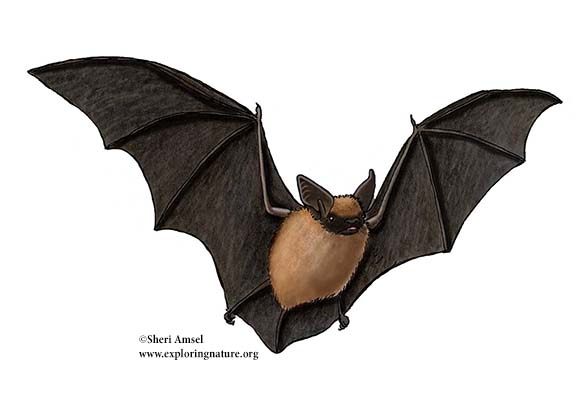

They live in the western North America from southern Alaska and southwestern Canada, through the western U.S. to southern Mexico.
They live in a wide range of habitats from forests to grasslands and dry scrublands.
They are one of the smaller North American bats weighing less than 1/5 of an ounce. The fur can be brown to reddish-orange in color. Their wings and tail membranes (uropatagium) are black. Their ears are long and black in color.
They come out to hunt for insects at dusk and dawn using echolocation. During the day, they roost in cracks in rocks, under the bark of trees, or in abandoned building. In the winter, they hibernate underground in mines or caves.
They eat moths, flies and other flying insects.
Females gather in small breeding colonies in the spring and give birth to a single baby (pup) in June-July. Males do not help with young.
They have been affected by white-nose syndrome, a deadly fungal disease that has hurt so many North American bat species. Though they are listed on the IUCN Red list as "least concern" the fungal disease may affect their long term populations.
Related Resources:
High Resolution Diagram
Kingdom: Animalia
Phylum: Chordata
Class: Mammalia
Order: Chiroptera
Family: Vespertilionidae
Genus: Myotis
Species: M. californicus
When you research information you must cite the reference. Citing for websites is different from citing from books, magazines and periodicals. The style of citing shown here is from the MLA Style Citations (Modern Language Association).
When citing a WEBSITE the general format is as follows.
Author Last Name, First Name(s). "Title: Subtitle of Part of Web Page, if appropriate." Title: Subtitle: Section of Page if appropriate. Sponsoring/Publishing Agency, If Given. Additional significant descriptive information. Date of Electronic Publication or other Date, such as Last Updated. Day Month Year of access < URL >.
Amsel, Sheri. "Bat (California myotis)" Exploring Nature Educational Resource ©2005-2024. December 14, 2024
< http://www.exploringnature.org/db/view/California-myotis-bat >

